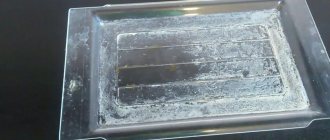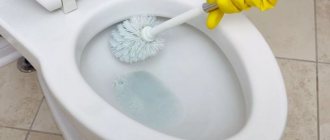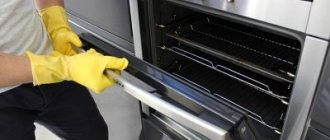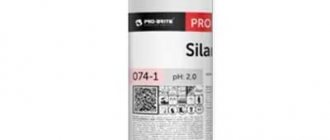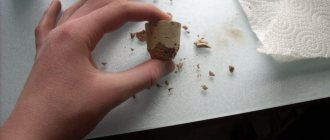The presence of limescale on plumbing fixtures (mixer, faucet), shower stall, toilet, sink or tiles in the bathroom is a common occurrence. The cause of its occurrence is hard water containing large amounts of calcium and magnesium salts.
Video recommendations for cleaning the bathroom
When salts get on metal or ceramic surfaces, they create a hard and difficult-to-remove layer that cannot be removed with hot water or a regular soap solution. Therefore, the question “How to remove limescale, and what products to use?” remains relevant.
For products made of nickel and chromium, it is advisable to use detergents dissolved in warm water or formulations with soft abrasives (wax, ammonia). The use of coarse abrasives is completely eliminated.
Folk remedies for cleaning plumbing fixtures
There are many ways using home remedies to ensure high-quality cleaning of even heavily soiled surfaces.
Common food products available in every housewife's kitchen are suitable for these purposes:
- Table vinegar (6%) or apple cider vinegar;
- Lemon acid.
To achieve the desired result, you need to know how to properly use homemade solutions from these products.
A wonderful neighbor moved into our house
Remember the line from the song? About a month ago this also happened in our house. A new neighbor and his wife moved in. She really helped me a lot. It all started quite normally: Olga came to meet me. It turned out that she is a chemistry teacher who has been teaching in one of the schools in our city for 15 years. A pleasant interlocutor with whom we immediately became on first-name terms. We chatted a little while I finished drawing eyes on my freshly made soap bear cubs (for which I managed to grab a couple of sincere compliments), and then we went to the kitchen to drink tea.
Olga accidentally glanced at my work area (right where I have the sink and dishwasher, which was a gift from my husband). This is my pride! I'm chewing gingerbread, waiting for compliments. But the dialogue we had with her was completely different:
- Why don’t you watch the tap? Look how much plaque is already on it.
- Yes, somehow... I feel sorry for the money for expensive chemicals...
– Wouldn’t you mind buying a new faucet when this one goes bad? But he’ll get spoiled with this approach, you’ll have to wait. And in general, you can do without expensive means, I’m telling you this as a chemist.
Olga further said that you can solve the problem with ordinary table vinegar. True, I had to listen to a short but very informative chemical lecture. I think it will be very useful for you too. Therefore, I am retelling the words of the chemistry teacher.
Table and apple cider vinegar
The simplest and most inexpensive remedy for limescale is a weak solution of white vinegar. But if the diluted composition does not cope well, its concentration should be gradually increased. The product is applied directly to the surface of the faucet or mixer being treated.
Abundant wetting with the solution is carried out in those places where there is a dense layer of plaque. After a 30-minute exposure, the product is applied to the surface again and after the same time, the limestone build-up is removed using a soft sponge or brush.
note
To get the best result, it is advisable to soak removable parts (faucet and shower sprayers) in the solution. Vinegar will help get rid of plaque on the sink and wash almost any heavily soiled surface.
To carry out the procedure, a glass of 6% product is heated, but not brought to a boil, and then poured into the sink (the drain should be blocked with a stopper). The lime layer must be completely covered with the product; if the quantity is not enough, additional volume must be prepared.
The solution is left overnight and drained in the morning, after which the remaining contamination is very easily removed. In the same way, you can treat a toilet and a metal or acrylic bathtub.
Cleaning limescale deposits on a shower hose with vinegar
Table vinegar easily cleans tiles. A freshly prepared solution can restore the original shine of ceramic tiles and clean the tile joints without much effort.
For convenience, you need to use a spray nozzle, with which the solution is simply and quickly applied to the surface. After 15-20 minutes, the cleaning composition is washed off with water.
Thanks to the active action of acetic acid, it is not difficult to get rid of limescale. At the final stage, wipe the surface dry with a microfiber cloth.
Instead of 6% table vinegar, you can use an essence with a consistency of 80%, which is diluted with water in a ratio of 1:12.
Vinegar - a remedy for stubborn stains
To dissolve more serious lime deposits on ceramic and glass items, chrome taps and pipes, 9% table vinegar is useful. It must be spread over the surface and left for 15-30 minutes.
To remove old limescale, vinegar must be in contact with it for at least an hour. Then you need to wipe the treated area with a dampened cloth or use a melamine sponge for better effect.
A brush is ideal for cleaning the toilet. To treat the shower head from plaque, you can tie a bag filled with vinegar to it. Next, rinse the surfaces with warm water and wipe dry.
Lemon acid
Some precautions should be taken when working with citric acid. Due to the fact that the product consists of small crystals, the sponge is first wetted in water and then lowered into the cleaning product. Such actions will help avoid the formation of scratches on the surface being treated.
Removing limescale in the bathroom using citric acid is performed on metal or acrylic coatings. This method is also suitable for ceramic sinks and plumbing fixtures and will help remove limescale from the faucet.
To carry out the procedure, you will need 2-3 bags of food product and a sponge, which, depending on the area being treated, can be medium or large in size.
Prepare and use the plaque and dirt remover as follows:
- Citric acid is poured into water at the rate of ½ packet per 1 glass and stirred thoroughly.
- The prepared solution is applied with a sponge. Particular attention is paid to areas with dents and kinks, if any, on the surface.
- After 20 minutes, the procedure is repeated, after which the treated area is rinsed with water.
To care for plastic and glass surfaces, you can use a soap solution, but the best effect is obtained from the use of citric acid. This is a minimum of time and money, as well as the safest and most harmless product that does not affect the condition of the hands and the surface being treated.
Using this method, it will not be difficult to remove limescale in the bathroom. How to remove a persistent layer of plaque and rust using traditional household chemicals?
Borax
With borax (borax, sodium tetraborate), Soviet housewives fought the problem of limescale. Today, this substance, which is a powerful universal cleaner for smooth surfaces, has been unfairly forgotten.
To clean tiles in the bathroom or kitchen, dissolve 2 tsp. sodium tetraborate in ½ liter of warm water. Pour the resulting liquid into a container equipped with a spray nozzle. Spray the surface with plaque. They let him work a little. Then wash off with clean water. This borax solution is also suitable for cleaning your dishwasher.
To clean the toilet, dissolve ½ cup of Borax in water (2 liters). Moisten a brush in the resulting solution and treat problem areas with it. Leave for 1-2 hours so that lime deposits and dirt are soaked. Then clean the toilet again with a brush and rinse with water.
How to remove lime deposits from an acrylic surface
Acrylic plumbing requires special care, so you should pay attention to the cleaning composition, which should not be abrasive. There are many ways to remove limescale from the surface of an acrylic bathtub or sink, but the best is a solution with citric acid or a soap solution with the addition of table vinegar.
Caring for an acrylic bathtub - video tips from a housewife
Such compositions cope well with yellowness from rust and lime deposits. After careful treatment, the surface of the bath will shine with cleanliness, and the room will be completely transformed.
How to avoid a large accumulation of plaque
The following actions help to avoid the formation of salt deposits:
- Rinse sanitary ware after each use. The bathtub must be cleaned of skin particles, cosmetics, and soap.
- Filter installation. This helps extend the life of plumbing fixtures and improve water quality.
- Refusal to wash or soak clothes in the bath.
- Timely repair of plumbing fixtures. It is necessary to eliminate leaking taps and toilet tanks.
- Refusal to use hard sponges and abrasives. Improper care contributes to the appearance of cracks in which dirt accumulates.
Clean the bathtub at least once a week.
How to remove yellow stains from glass
Each bathroom has a mirror or shelf made of durable glass, which also require maintenance. Cleaning the glass surface has its own specifics - the use of abrasives is not acceptable.
Any abrasive, no matter how soft, will cause scratches on the coating that will be impossible to remove. In this case, the best solution would be to use a solution of washing powder or any specialized product.
Simple but effective advice - how to clean a mirror from plaque
For example, an effective remedy is a gel with the addition of a small amount of vinegar or ammonia. Stubborn stains can easily be removed with a solution of 1 teaspoon of citric acid diluted in a glass of water.
Features of cleaning various bathtub coatings
Different materials require an individual approach. Fragile surfaces can be damaged by coarse powder particles or aggressive compounds. Therefore, before choosing a cleaning product, determine the type of coating.
Enamel
Features of enamel coating:
- They tolerate chlorine-based cleaning products well: Belizna, Domestos.
- Allows cleaning with fine abrasives: Comet powders, Pemolux, soda. But you can’t use them to clean old cast-iron bathtubs with a thin layer of enamel, otherwise you can scratch the coating.
- Does not tolerate the effects of strong acids: nitric, phosphoric, hydrochloric, oxalic, formic, citric. The acid destroys the enamel, so the surface loses its shine and color and becomes rough.
To avoid ruining your bath, use soft sponges. How to clean limescale:
- Mister Muscle for the bathroom;
- a weakly concentrated solution with bleach, bleach, lemon (ratio with water 1:3);
- Cif cream;
- Comet spray.
Acrylic
There are no pores on acrylic surfaces, so these bathtubs practically do not get dirty and are easy to clean. For cleaning, regular soap or a solution based on lemon juice or citric acid is suitable. But it is better to use specialized tools:
- San Klin “For washing acrylic bathtubs”;
- Cif Cream “Universal”;
- Unicum “Spray for acrylic bathtubs”;
- POSTIRON ACRYLIC;
- Sanfor "Spray foam Acrylight";
- “Cinderella” emulsion for acrylic bathtubs.
Do not rub the acrylic bathtub with powders, hard sponges, or bleach.
Stainless steel
A steel bathtub does not tolerate high temperatures well, so you cannot wash it with hot water - this can lead to cracks. Otherwise, the material is easy to care for, but you only need to apply the products with a soft sponge so as not to scratch the coating. Special store chemicals:
- Steel Polish Grass Spray;
- Jundo Plumbing cleanser;
- Lemark "Anticalcium".
Gentle home remedy:
- mix 9% vinegar and hydrogen peroxide in a 2:1 ratio;
- Apply the mixture to the surface and leave for 30 minutes;
- take an old toothbrush and toothpaste. Treat solid deposits;
- Rinse everything off thoroughly.
Cast iron
Cast iron bathtubs are unpretentious and easy to clean if there are no scratches or other mechanical damage on the surface. Any detergent will do, but only soft sponges can be used. For old stains, use soda or powders containing weak acids, alkali or chlorine.
Ceramics
Lime also accumulates on the tiles. Especially at joints and in hard-to-reach places where water flows (for example, between the wall and the sink). Aggressive chemicals can ruin the color and shine of tiles, so it is better to use gentle methods. Homemade plaque removal recipe:
- mix 150 g of citric acid in 250 ml of warm water;
- pour the solution into a spray bottle and spray evenly over the surface;
- rinse off after 20 minutes;
- if there is plaque left somewhere, soak a cloth in the solution and apply it to the problem areas or scrub with an old toothbrush.
Instead of citric acid, you can take 9% food vinegar.
Household chemicals:
- HG concentrate for removing limescale;
- Sanfor “Anti-raid” spray;
- Pro-Brite Rust remover spray.
Glass
Cleaning the glass is easy: you can wash off the deposits with a regular soap solution. If you don’t have a special product at home, try the following recipes:
- soak a soft, lint-free cloth in a small amount of table vinegar and wipe the surface.
- soak a cloth with ammonia and treat mirrors and glass.
- Squeeze the lemon, strain the juice and clean the surfaces with it.
If marks remain after treatment, rub them with a melamine sponge. Then go through the acid or alcohol again. Purchased products include sprays for windows and showers.
Plastic
To avoid scratching the plastic, do not use hard sponges or abrasives. Use 9% vinegar: soak a rag in it and treat the stain. Apply a cloth soaked in vinegar to old stains for 20 minutes.
When choosing industrial household chemicals, make sure that the composition does not contain aggressive solvents or formic acid. A universal spray for complex limescale deposits, Mr. Proper Professional.
How to clean ceramic tiles
There are practically no difficulties in caring for tiles, but this is only the case when it is permanent. If dirt appears on the surface and on the seams, then you urgently need to start cleaning them. But how to clean the tiles efficiently so that they shine in a new way?
An effective product for cleaning tiles from old grease. watch the video.
The methods are the same as for cleaning metal, acrylic and glass surfaces. Using folk remedies, we wash the tiles without any difficulties. You can use the recipes already described above.
Limescale removal products should be selected for each specific case, depending on the degree of contamination and persistence of the deposits.
How do I clean household appliances?
Teapot and coffee maker
This appliance in my house suffers the most from hard water. Therefore, I regularly clean them from the scale that forms on the bottom and walls.
Cleaning the kettle:
- I fill it with vinegar solution (in a ratio of 1 to 1).
- I pour it in and leave it overnight.
- In the morning, I simply pour out the solution along with the residue, and I rinse the kettle itself several times to remove the smell of vinegar.
It is advisable to clean scale regularly, since plaque is dangerous to health (Photo: torange.biz)
Cleaning the coffee maker is also easy:
- I make the same solution from vinegar and pour it into a water container.
- I start the machine without adding coffee - the prepared mixture will wash all the insides where scale usually forms.
- I repeat the process 2-3 times, adding regular water.
Tip: someone I know once cleaned a new coffee maker this way, ignoring the special branded cleaner that the manufacturer recommended. In their case, everything worked out fine, but if the coffee maker had broken down, the use of “folk” remedies could have voided the official warranty.
Household chemicals for removing limescale and rust from the surface of the bathtub
Professional cleaning of the bathtub from limescale is carried out using household chemicals. These products are presented in a huge range, but the most effective drugs that are used most often are: Domestos, Comet, Pemolux, etc.
These compounds can not only be used to clean cast iron and metal surfaces of the bathtub, faucet and shower hose, they are also suitable for caring for tiles. Instructions for use are included with each product. The main thing is to follow safety rules during use.
Knowing all the folk remedies and modern household chemicals, cleaning off limescale and rust will not be particularly difficult. But the choice is always yours!
Faucet cleaners
You can remove limescale, rust stains, soap stains or finger stains with specialized products or products available at home.
Traditional methods
Home remedies are safe for health and do not contain harmful fumes. Their use is recommended for small deposits of water stone.
To clean the faucet safely for the surface, vinegar (9%) is mixed with water 1:1. The entire device is wiped with the resulting solution. For persistent contamination, you will need to extend the action of acetic acid. To do this, soak a napkin in the solution and wrap the problem area for 1 hour. After the procedure, the tap is washed with warm water. Table salt is added to vinegar, this helps to add shine to the metal.
Citric acid does an excellent job of removing plaque. It is used in the form of lemon juice or an aqueous solution. You will need a small container of warm water in which a bag of citric acid is dissolved. Apply the mixture onto the mixer with a sponge and wash off after 10-15 minutes. Cut a fresh lemon into 2 halves and rub the pulp over the entire surface of the device. After the deposits have softened, rinse the surface of the tap.
Soda effectively cleans any dirt and disinfects the surface of plumbing fixtures. A paste mixture is prepared from soda and water. Apply it to the tap with a sponge or toothbrush. The surface is gently rubbed, this allows you to remove deposits and gently polish the metal. Residues are removed with a damp cloth.
Laundry soap contains fatty acids and alkalis and has antibacterial properties. Mode of application:
- rub a bar of laundry soap on a grater;
- add warm water;
- stir the composition to a paste consistency;
- add 1 teaspoon of soda;
- wipe the faucet with the mixture and do not rinse for an hour;
- remove soap, rinse the device.
Soap is one of the most accessible and effective means, but it requires more effort to use.
Cola , which contains phosphoric acid, is used as a plumbing cleaner. It removes rust and limescale. Moisten a sponge with cola and wipe the mixer. The liquid destroys deposits and restores the shine of the metal.
Specialized
Products intended for metal taps should gently remove plaque and dirty stains and maintain shine.
- Mangia Calcare is a spray that removes limescale and reduces subsequent deposits. The product of the Italian brand is suitable for faucets, tiles, shower glass.
- GroheClean is a reliable but expensive product for cleaning taps and mixers. It is made on the basis of citric acid and delicately removes limescale formations and corrosion.
- Cif cream - a soft composition with microcrystals does not harm the surface, is easy to apply and wash off. To completely remove deposits, leave the product on the surface for several minutes.
- Cif anti-plaque bath spray - effectively cleans chrome and nickel plated surfaces, stainless steel. The product is easy to use and economical in consumption.
- Radomir - detergent eliminates lime deposits and rust. The spray does not contain abrasive particles and restores the shine of the metal.
Specialized products contain acids in a safe concentration, but their exposure time must not be exceeded.
Why does plaque appear on the toilet?
Limescale and rust deposits often form on the toilet
Limescale or rust deposits usually form on plumbing fixtures. There are deposits of water stone. Each of the pollution is caused by its own reasons.
Corrosion is formed due to the high content of dissolved iron and its compounds, as well as due to the destruction of cast iron pipes. The problem is relevant for Soviet-built areas, where water pipes of outdated models are still used.
The formation of limescale is associated with a large amount of calcium and magnesium dissolved in water. In different regions and even areas of the same city, the percentage of mineral content may differ. A standard filtration system does not remove minerals and heavy salt compounds. Water supplied to apartments through a centralized system undergoes only basic purification, i.e., large debris, harmful impurities and bacteria are removed.
Waterstone is dried urea deposits. Biological waste penetrates into microcracks, forming growths and stains of contamination. Their layering occurs gradually. Frequent use of the toilet leads to the rapid formation of urinary stones.
Where does plaque come from?
I would like to note right away that it is almost impossible to prevent the appearance of plaque, since the main reason for its appearance is the evaporation of water, which interacts with soap.
True, tap water even by itself leaves a residue, since it contains a large amount of mechanical particles and salts. After the water dries, all these minerals and other elements are deposited on the surface in the form of a gray coating. If the water is rich in iron, it can also color the surface a characteristic orange color. As a result, a snow-white bathroom in a very short time turns into an unsightly container of a “gray-brown-raspberry” color.
Limescale may appear on faucets and other surfaces
Of course, after each use you can wipe the bathtub with a dry cloth. In this case, you will not see the plaque soon. However, it is impossible to keep track of all the drops that fall on the surface, so sooner or later you will still have to face the need to remove deposits.
Currently, there are many household chemicals on sale that effectively clean both types of plaque. However, most formulations are based on acids, as a result of which they are very toxic and can even cause burns if they come into contact with the skin. Powder products are more environmentally friendly, however, they scratch the surface of the plumbing fixtures, as a result of which it gradually loses its original attractive appearance.
Therefore, all kinds of “folk” remedies are very relevant in our time.
Causes of limescale deposits
The appearance of limescale on a kettle, sink, faucet, tiles and other surfaces is due to their contact with water. When water evaporates, calcium carbonate (white coating) is formed on the surface. Removing it without using special media is not an easy task.
The main reasons for the appearance of limescale:
- Untimely flushing. Stagnant water is one of the main causes of limescale deposits. In addition, on the plumbing of toilets and urinals, urinary stone is added to the limescale deposits. It is almost impossible to cope with such pollution without professional household chemicals.
- Hot or hard water. In hard, mineral-rich water, limescale forms much faster. An excess of such deposits leads to malfunction of coffee makers, electric kettles, washing machines and dishwashers.
It is important to clean heating elements regularly.
To soften too hard water, special means are used:
- install an ion or membrane filter;
- use specialized household chemicals;
- use saline solution.
Important: limescale negatively affects the quality of drinking water and quickly leads to wear and tear of electrical appliances.
- Damaged surface. The surface on which there are chips, scratches, and other types of damage is the first to form limescale. It is extremely difficult to remove plaque from such places; you will need to use products that can penetrate deep into the contamination.
Special compounds for plumbing
Place the faucet in a solution of liquid Antiscale to clean it inside
Liquid Antiscale and Cillit will clean the faucet from the outside and inside. To do this, you will have to first remove it or at least unscrew it from the sink and leave it to soak in the prepared solution. After soaking, all that remains is to rinse the faucet with clean water and put it back in its original place, then drain the water so that the inner surface is thoroughly washed from contaminants.
To remove limescale, you should not purchase products containing nitrogen, salt, sulfur or phosphorus compounds. The use of such compounds can lead to a new problem - the formation of dark spots and rust that is difficult to remove, so they are best used in very rare cases. Manufacturers of such products are required to notify buyers of the content of potent substances with an inscription on the label.
How to remove limescale from plastic or vinyl chloride
It is better not to treat plastic or PVC pipes, connecting parts and interior items with vinegar, ammonia, or citric acid. It is better to use another proven method - carbonated drinks.
You will need carbonated drinks that contain phosphoric acid. This could be Coca-Cola, Sprite or 7Up. It's better to use the last two as they have no color. Only original drinks are suitable, because some “Bell” or “Bel-Cola” do not contain phosphoric acid.
- Soak a rag or napkin in the carbonated drink;
- Apply to the surface of the pipe or panel;
- Leave for 2-3 hours. If necessary, add a carbonated drink;
- Remove the cloth and thoroughly rinse off any remaining limescale.
After this treatment, the surfaces will return to their attractive appearance.



